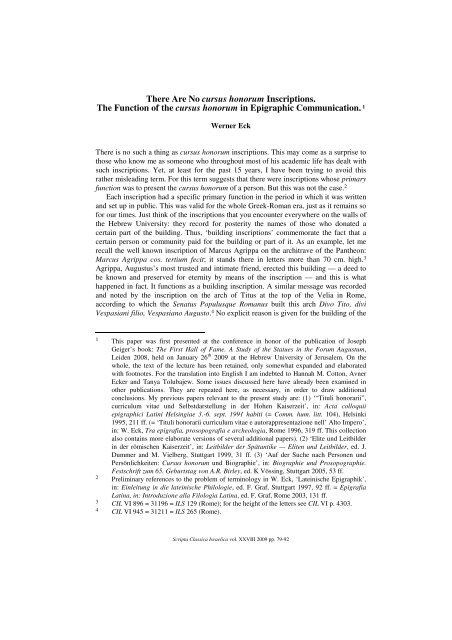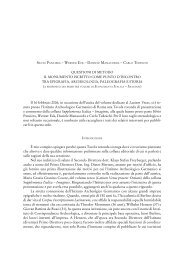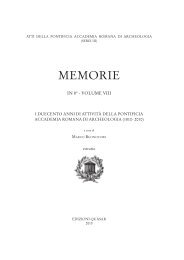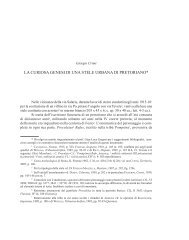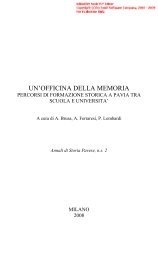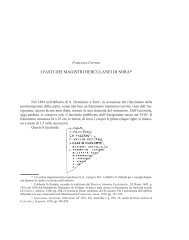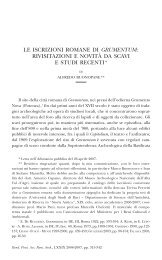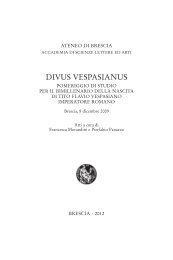There Are No cursus honorum Inscriptions. The Function of the ...
There Are No cursus honorum Inscriptions. The Function of the ...
There Are No cursus honorum Inscriptions. The Function of the ...
Create successful ePaper yourself
Turn your PDF publications into a flip-book with our unique Google optimized e-Paper software.
<strong><strong>The</strong>re</strong> <strong>Are</strong> <strong>No</strong> <strong>cursus</strong> <strong>honorum</strong> <strong>Inscriptions</strong>.<br />
<strong>The</strong> <strong>Function</strong> <strong>of</strong> <strong>the</strong> <strong>cursus</strong> <strong>honorum</strong> in Epigraphic Communication. 1<br />
Werner Eck<br />
<strong><strong>The</strong>re</strong> is no such a thing as <strong>cursus</strong> <strong>honorum</strong> inscriptions. This may come as a surprise to<br />
those who know me as someone who throughout most <strong>of</strong> his academic life has dealt with<br />
such inscriptions. Yet, at least for <strong>the</strong> past 15 years, I have been trying to avoid this<br />
ra<strong>the</strong>r misleading term. For this term suggests that <strong>the</strong>re were inscriptions whose primary<br />
function was to present <strong>the</strong> <strong>cursus</strong> <strong>honorum</strong> <strong>of</strong> a person. But this was not <strong>the</strong> case. 2<br />
Each inscription had a specific primary function in <strong>the</strong> period in which it was written<br />
and set up in public. This was valid for <strong>the</strong> whole Greek-Roman era, just as it remains so<br />
for our times. Just think <strong>of</strong> <strong>the</strong> inscriptions that you encounter everywhere on <strong>the</strong> walls <strong>of</strong><br />
<strong>the</strong> Hebrew University: <strong>the</strong>y record for posterity <strong>the</strong> names <strong>of</strong> those who donated a<br />
certain part <strong>of</strong> <strong>the</strong> building. Thus, ‘building inscriptions’ commemorate <strong>the</strong> fact that a<br />
certain person or community paid for <strong>the</strong> building or part <strong>of</strong> it. As an example, let me<br />
recall <strong>the</strong> well known inscription <strong>of</strong> Marcus Agrippa on <strong>the</strong> architrave <strong>of</strong> <strong>the</strong> Pan<strong>the</strong>on:<br />
Marcus Agrippa cos. tertium fecit; it stands <strong>the</strong>re in letters more than 70 cm. high. 3<br />
Agrippa, Augustus’s most trusted and intimate friend, erected this building — a deed to<br />
be known and preserved for eternity by means <strong>of</strong> <strong>the</strong> inscription — and this is what<br />
happened in fact. It functions as a building inscription. A similar message was recorded<br />
and noted by <strong>the</strong> inscription on <strong>the</strong> arch <strong>of</strong> Titus at <strong>the</strong> top <strong>of</strong> <strong>the</strong> Velia in Rome,<br />
according to which <strong>the</strong> Senatus Populusque Romanus built this arch Divo Tito, divi<br />
Vespasiani filio, Vespasiano Augusto. 4 <strong>No</strong> explicit reason is given for <strong>the</strong> building <strong>of</strong> <strong>the</strong><br />
1 This paper was first presented at <strong>the</strong> conference in honor <strong>of</strong> <strong>the</strong> publication <strong>of</strong> Joseph<br />
Geiger’s book: <strong>The</strong> First Hall <strong>of</strong> Fame. A Study <strong>of</strong> <strong>the</strong> Statues in <strong>the</strong> Forum Augustum,<br />
Leiden 2008, held on January 26 th 2009 at <strong>the</strong> Hebrew University <strong>of</strong> Jerusalem. On <strong>the</strong><br />
whole, <strong>the</strong> text <strong>of</strong> <strong>the</strong> lecture has been retained, only somewhat expanded and elaborated<br />
with footnotes. For <strong>the</strong> translation into English I am indebted to Hannah M. Cotton, Avner<br />
Ecker and Tanya Tolubajew. Some issues discussed here have already been examined in<br />
o<strong>the</strong>r publications. <strong>The</strong>y are repeated here, as necessary, in order to draw additional<br />
conclusions. My previous papers relevant to <strong>the</strong> present study are: (1) ‘“Tituli honorarii”,<br />
curriculum vitae und Selbstdarstellung in der Hohen Kaiserzeit’, in: Acta colloquii<br />
epigraphici Latini Helsingiae 3.-6. sept. 1991 habiti (= Comm. hum. litt. 104), Helsinki<br />
1995, 211 ff. (= ‘Tituli honorarii curriculum vitae e autorappresentazione nell’ Alto Impero’,<br />
in: W. Eck, Tra epigrafia, prosopografia e archeologia, Rome 1996, 319 ff. This collection<br />
also contains more elaborate versions <strong>of</strong> several additional papers). (2) ‘Elite und Leitbilder<br />
in der römischen Kaiserzeit’, in: Leitbilder der Spätantike — Eliten und Leitbilder, ed. J.<br />
Dummer and M. Vielberg, Stuttgart 1999, 31 ff. (3) ‘Auf der Suche nach Personen und<br />
Persönlichkeiten: Cursus <strong>honorum</strong> und Biographie’, in: Biographie und Prosopographie.<br />
Festschrift zum 65. Geburtstag von A.R. Birley, ed. K Vössing, Stuttgart 2005, 53 ff.<br />
2 Preliminary references to <strong>the</strong> problem <strong>of</strong> terminology in W. Eck, ‘Lateinische Epigraphik’,<br />
in: Einleitung in die lateinische Philologie, ed. F. Graf, Stuttgart 1997, 92 ff. = Epigrafia<br />
Latina, in: Introduzione alla Filologia Latina, ed. F. Graf, Rome 2003, 131 ff.<br />
3 CIL VI 896 = 31196 = ILS 129 (Rome); for <strong>the</strong> height <strong>of</strong> <strong>the</strong> letters see CIL VI p. 4303.<br />
4 CIL VI 945 = 31211 = ILS 265 (Rome).<br />
Scripta Classica Israelica vol. XXVIII 2009 pp. 79-92
80 THERE ARE NO CURSUS HONORUM INSCRIPTIONS<br />
arch, but <strong>the</strong> reliefs within <strong>the</strong> passage speak clearly: <strong>the</strong>y refer to Titus’ victory over<br />
Jerusalem. Many more examples <strong>of</strong> such building inscriptions could be added.<br />
Dedications to deities were a related but different category. Any inscription placed on<br />
<strong>the</strong> architrave <strong>of</strong> a temple is a dedicatory inscription, which may also be termed a<br />
building inscription, like Agrippa’s inscription on <strong>the</strong> Pan<strong>the</strong>on. However, not every<br />
dedicatory inscription was a building inscription. Such texts were placed on different<br />
objects as well, for example on altars or under statues <strong>of</strong> gods, like <strong>the</strong> object or <strong>the</strong><br />
statue that was erected by a vexillatio <strong>of</strong> <strong>the</strong> legio III Cyrenaica for Iupiter Optimus<br />
Maximus Sarapis in <strong>the</strong> year 116 AD in Jerusalem. 5 This double purpose was also <strong>of</strong>ten<br />
found in grave inscriptions: on <strong>the</strong> one hand a grave inscription implied <strong>the</strong> building <strong>of</strong> a<br />
mausoleum, and on <strong>the</strong> o<strong>the</strong>r hand, it served as a memorial inscription for <strong>the</strong> deceased,<br />
meant to commemorate his name for his contemporaries as well as for future generations.<br />
Take for example <strong>the</strong> grave inscription for M. <strong>No</strong>nius Macrinus discovered only a few<br />
months ago in Rome. <strong>The</strong> inscription was placed on a mausoleum probably more than 10<br />
meters high on <strong>the</strong> bank <strong>of</strong> <strong>the</strong> Tiber. <strong>The</strong> fragments give us an idea <strong>of</strong> <strong>the</strong> size and<br />
grandeur <strong>of</strong> <strong>the</strong> original memorial construction. <strong>The</strong> text itself informs us that <strong>the</strong><br />
homonymous son <strong>of</strong> <strong>the</strong> deceased had this monumental grave built for his fa<strong>the</strong>r, consul<br />
suffectus in <strong>the</strong> year 154, and for his mo<strong>the</strong>r, whose name we did not know until now. 6<br />
But above all, <strong>the</strong> inscription and monument are meant to preserve <strong>the</strong> memory <strong>of</strong> <strong>the</strong><br />
senator. 7 In addition to <strong>the</strong> tituli related to <strong>the</strong> building <strong>of</strong> <strong>the</strong> tomb, <strong>the</strong>re are numerous<br />
simple grave inscriptions, well over 40.000 examples in Rome alone, inscribed on larger<br />
marble slabs or smaller ones attached to individual graves <strong>of</strong> single persons. <strong>The</strong>se<br />
inscriptions do not speak <strong>of</strong> <strong>the</strong> erection <strong>of</strong> a monument but merely <strong>of</strong> <strong>the</strong> death and<br />
burial <strong>of</strong> individuals, whose memory will thus live on. 8<br />
5 CIL III 13587 = ILS 4393 (Jerusalem): [I]ovi Optimo Maximo Sarapidi pro salute et<br />
victoria Imp(eratoris) Nervae Traiani Caesaris Optumi Aug(usti) Germanici Dacici Parthici<br />
et populi Romani vexill(atio) leg(ionis) III Cyr(enaicae) fecit. Since <strong>the</strong> inscription was<br />
brought to Istanbul but has since disappeared, we know nothing about <strong>the</strong> exact form <strong>of</strong> <strong>the</strong><br />
stone. Indeed, <strong>the</strong> assumption is that <strong>the</strong> stone had a square block form. Thus it could have<br />
been part <strong>of</strong> a wide altar or could even have served as a base ei<strong>the</strong>r for a statue <strong>of</strong> <strong>the</strong> God,<br />
or, more probably, for a Serapis foot as a symbol for <strong>the</strong> god himself. On Serapis feet, which<br />
were found in <strong>the</strong> Roman Empire, see L. Castiglione, ‘Zur Frage der Sarapis Füße’,<br />
Zeitschrift für Ägyptische Sprache und Altertumskunde 97, 1971, 122 ff.; K. Lemke, Das<br />
Iseum Campense in Rom, 1994.<br />
6 PIR 2 N 140.<br />
7 <strong>The</strong> text which may be determined from <strong>the</strong> photograph on <strong>the</strong> internet, reads<br />
approximately: M NONIO M F FAB M[A]CRINO [COS PROCOS ASIAE XVVIR<br />
SACRIS FACIVNDIS SODALIS ANTONINIANVS ] / COMITI LEG IMP ANTONINI<br />
AVG EX[PEDITIONE GERMANICA LEG AVG PR PRAETORE PROVINCIARVM<br />
PANNONIAE] / INFERIORIS ITEM PANNONIAE SVP[ERIORIS CVRATORI ALVEI<br />
TIBER LEG LEG XIV GEMINAE PRAETORI TRIBVNO PLEBIS LEG] / PROVINCIAE<br />
ASIAE QVAESTO[RI TRIBVNO LEG XVI FLAVIAE DECEMVIRO STLITIBVS<br />
IVDICANDIS] / PATRI OPTIMO ET FLAVI[----- MATRI----] / M NONIV[S<br />
MACRINVS FILIVS].<br />
8 <strong>The</strong> distinction between a titulus, testifying to <strong>the</strong> setting up <strong>of</strong> a grave, and between <strong>the</strong><br />
individual grave inscription is not always taken into account in <strong>the</strong> statistical evaluation <strong>of</strong><br />
funerary inscriptions.
WERNER ECK 81<br />
Recording <strong>the</strong> memory <strong>of</strong> an individual also played a part in many inscriptions<br />
displayed under statues. <strong>The</strong>y enumerated <strong>the</strong> honours held by a person and <strong>the</strong>refore<br />
were almost universally labelled by scholars as “honorary inscriptions.” However, this<br />
term is also wrong or, at least, very problematic, if I am right in using this English term<br />
to mean <strong>the</strong> same as <strong>the</strong> German Ehreninschrift, which means that <strong>the</strong> inscription itself<br />
embodied <strong>the</strong> honour. But, so far as I can see, this was never <strong>the</strong> case in <strong>the</strong> Roman<br />
context. Such inscriptions recorded, in stereotyped form, <strong>the</strong> decision passed by a city,<br />
by a collegium, or by one or more private individuals, to pay an appropriate tribute to a<br />
person, in <strong>the</strong> form <strong>of</strong> a statue or a portrait. 9 Frequently it was specified that an<br />
inscription should be put under <strong>the</strong> monument, and sometimes <strong>the</strong> wording <strong>of</strong> <strong>the</strong><br />
inscription was prescribed. This happened, for example, in a decision <strong>of</strong> <strong>the</strong> municipality<br />
<strong>of</strong> Herculaneum probably in <strong>the</strong> Augustan period. <strong>The</strong> council decided <strong>the</strong> following:<br />
statuam equestrem ei poni quam celeberrimo loco ex pecunia publica inscribique<br />
M(arco) <strong>No</strong>nio M(arci) f(ilio) Men(enia) Balbo pr(aetori) proco(n)s(uli) patrono. 10 This<br />
example shows quite clearly that <strong>the</strong> actual honour consisted in <strong>the</strong> construction <strong>of</strong> a<br />
statue itself, in this case an equestrian statue, as is explained by <strong>the</strong> inscription seen by<br />
everyone who visited <strong>the</strong> locus celeberrimus in Herculaneum. <strong>The</strong> importance <strong>of</strong> <strong>the</strong><br />
image, that is <strong>the</strong> statue, as <strong>the</strong> crucial part <strong>of</strong> <strong>the</strong> honour, is highlighted by <strong>the</strong> absence<br />
<strong>of</strong> any inscription when <strong>the</strong> monument stood in <strong>the</strong> self-explanatory context <strong>of</strong> a private<br />
house, as we see in many examples from Pompeii. In <strong>the</strong> public space, inscriptions had<br />
to be set on <strong>the</strong> base, under <strong>the</strong> statue, in order to explain who was honoured with a<br />
statue and, <strong>of</strong> course, by whom. 11<br />
All <strong>the</strong>se different functional types <strong>of</strong> inscriptions: building inscriptions, various<br />
dedications, inscriptions on tombs and under statues etc., are also connected with <strong>the</strong><br />
topic that was <strong>the</strong> starting point <strong>of</strong> this lecture: <strong>the</strong> <strong>cursus</strong> <strong>honorum</strong>, <strong>the</strong> sequence <strong>of</strong><br />
public functions fulfilled by a person during his lifetime. A few examples will illustrate<br />
<strong>the</strong> variety <strong>of</strong> forms that <strong>the</strong> <strong>cursus</strong> <strong>honorum</strong> takes in epigraphic texts.<br />
<strong>The</strong> following building inscription 12 was found in Barcino in Spain, home town <strong>of</strong> <strong>the</strong><br />
senatorial family <strong>the</strong> <strong>the</strong> Minicii Natales: 13<br />
9 Numerous examples in ILS,<br />
10 AE 1947, 53 = AE 1976,144 (Herculaneum): [Qu]od M(arcus) Ofillius Celer IIvir iter(um)<br />
v(erba) f(ecit) pertinere at municipi dignitatem meritis M(arci) <strong>No</strong>ni Balbi respondere d(e)<br />
e(a) r(e) i(ta) c(ensuerunt): [Cu]m M. <strong>No</strong>nius Balbus quo hac vixerit parentis animum cum<br />
plurima liberalitat(e) singulis universisque praistiterit placere decurionibus statuam<br />
equestrem ei poni quam celeberrimo loco ex pecunia publica inscribique M. <strong>No</strong>nio M. f.<br />
Men. Balbo pr(aetori) proco(n)s(uli) patrono, universus ordo populi Herculanie(n)sis ob<br />
merita eius item eo loco quo cineres eius conlecti sunt aram marmoream fieri et constitui<br />
inscribique publice M. <strong>No</strong>nio M. f. Balbo exque eo loco parentalibu(s) pompam duci<br />
ludisque gymnicis qui soliti erant fieri diem edici unum in honorem eius et cum in <strong>The</strong>atro<br />
ludi fient sellam eius poni c(ensuerunt).<br />
11 In some dedications this was more <strong>of</strong>ten as important as <strong>the</strong> person to whom <strong>the</strong> honour was<br />
primarily directed; cf. W. Eck, ‘Statuendedikanten und Selbstdarstellung in römischen<br />
Städten’, in: L’Afrique, la Gaule, la Religion à l’époque romaine. Mélanges à la mémoire<br />
de M. Le Glay, ed. Y. Le Bohec, Brussels 1994, 650 ff.<br />
12 CIL II 4509 = ILS 1029 = <strong>Inscriptions</strong> Romaines de Catalogne IV Nr. 30 (Barcino) with<br />
photo.
82 THERE ARE NO CURSUS HONORUM INSCRIPTIONS<br />
L. Min[icius L. f. Gal. Na]talis cos. procos.<br />
provinc. [Africae sodalis Augus]talis leg. Aug. pr. praet. divi Traia-<br />
ni Part[hici et Imp. Traiani Ha]driani Aug. provinc. Pan-<br />
nonia[e superioris curator a]lvei Tiberis et riparum et<br />
cloacar[um urbis leg. divi Trai]ani Parthici leg. III Aug. leg. di-<br />
vi Traia[ni Parthici leg(ionis) --- doni]s donatus expeditione Dacic[a]<br />
prima a[b eodem Imperatore] corona vallari murali aurea<br />
has[tis puris III vexillis III] leg pr. pr. provinc. Africae pr.<br />
trib. pl. q. p[rovinc. --- IIIIv]ir viarum curandarum et<br />
L. Minicius L. f. [Natalis Quadro]nius Verus f. augur trib. pl.<br />
desig. q. Aug. et [eodem tempore leg. p]r. pr patris provinc. Africae tr.<br />
mil. leg. I Adiut. p. f. l[eg. XI Cl. p. f. leg. XIIII Ma]rt. Vic. IIIvir monetalis a. a. a. f. f.<br />
balineum c[um port]icibus solo suo et<br />
[ductus aquae] fecerunt.<br />
Two members <strong>of</strong> this family appear in <strong>the</strong> text. <strong>The</strong> inscription was engraved on a large<br />
marble slab and comprises fourteen lines: <strong>the</strong> text talks about <strong>the</strong> construction <strong>of</strong> a bath,<br />
including <strong>the</strong> porticoes and <strong>the</strong> appropriate aqueduct, by <strong>the</strong> senator L. Minicius Natalis<br />
and his son L. Minicius Natalis Quadronius Verus. This crucial statement, <strong>the</strong> primary<br />
cause for erecting <strong>the</strong> inscription, was placed only in <strong>the</strong> last two lines. It was written<br />
with much larger letters, so that <strong>the</strong> observer could be reminded <strong>of</strong> <strong>the</strong> deeds <strong>of</strong> <strong>the</strong><br />
donors, namely <strong>the</strong> act <strong>of</strong> benefaction by two senators for <strong>the</strong>ir home town. If one starts<br />
reading <strong>the</strong> text from <strong>the</strong> beginning, it would take a while to arrive at this statement. <strong>The</strong><br />
first twelve lines, <strong>the</strong> “overwhelming” part <strong>of</strong> <strong>the</strong> text, were filled with <strong>the</strong> names <strong>of</strong> <strong>the</strong><br />
two Minicii Natales, fa<strong>the</strong>r and son, and especially with <strong>the</strong> <strong>cursus</strong> <strong>honorum</strong> <strong>of</strong> both. <strong>The</strong><br />
<strong>cursus</strong> <strong>honorum</strong> <strong>of</strong> <strong>the</strong> fa<strong>the</strong>r ran in inverse order: it began with his proconsulate in<br />
Africa and ended with <strong>the</strong> Vigintivirat. Likewise, that <strong>of</strong> <strong>the</strong> son went from his role as<br />
tribunus plebis, <strong>the</strong> post to which <strong>the</strong> young senator was designated at <strong>the</strong> time <strong>of</strong><br />
writing, down to <strong>the</strong> Vigintivirat. In Barcino, <strong>the</strong>ir home town, it was unnecessary, <strong>of</strong><br />
course, to describe <strong>the</strong> rank <strong>of</strong> both; everyone knew this family, which was <strong>the</strong> most<br />
prominent in <strong>the</strong> community <strong>of</strong> this not-so-big provincial town. In order to identify <strong>the</strong><br />
authors <strong>of</strong> <strong>the</strong> benefaction, it would have sufficed to record <strong>the</strong>ir names alone on <strong>the</strong><br />
building inscription — at most <strong>the</strong> fa<strong>the</strong>r’s consulate, <strong>the</strong> summit <strong>of</strong> his career, could<br />
have been mentioned so as to place him in <strong>the</strong> senatorial hierarchy, whereas <strong>the</strong> son’s<br />
social position was already determined by <strong>the</strong> fa<strong>the</strong>r’s. However, this obviously did not<br />
satisfy <strong>the</strong> two senators. <strong>The</strong>y wished to document each and every one <strong>of</strong> <strong>the</strong>ir <strong>of</strong>fices in<br />
<strong>the</strong> service <strong>of</strong> <strong>the</strong> empire in order to make it clear how closely connected both fa<strong>the</strong>r and<br />
son were to <strong>the</strong> emperors Trajan and Hadrian. <strong>The</strong> inscription documented <strong>the</strong><br />
succession <strong>of</strong> positions achieved over many decades in <strong>the</strong> imperial service as members<br />
<strong>of</strong> <strong>the</strong> imperial elite.<br />
A second example, again from <strong>the</strong> documentary corpus <strong>of</strong> this family, and once more<br />
from Barcino, also stressed service in <strong>the</strong> imperial elite, but in a different context and in<br />
a different type <strong>of</strong> inscription. <strong>The</strong> text probably comes from <strong>the</strong> same bath, whose<br />
construction was recorded in <strong>the</strong> inscription just mentioned. But this time <strong>the</strong> inscription<br />
was not concerned with <strong>the</strong> act <strong>of</strong> construction itself, but with <strong>the</strong> public honouring <strong>of</strong> a<br />
13 See PIR 2 M 619. 620.
WERNER ECK 83<br />
benefactor. Only part <strong>of</strong> <strong>the</strong> inscription was preserved, but this is enough to reconstruct<br />
<strong>the</strong> text and identify <strong>the</strong> procedure. 14<br />
[L. Minicio L. f. Gal, Natali Quadronio Vero]<br />
[cos. procos. prov. Africae auguri leg. Aug pr. pr. prov. Moesiae inferioris]<br />
[curatori operum publicorum et aedium sacrar. curatori viae Flaminiae]<br />
[praef. alimentor. leg. Aug. leg. VI Victr. in Britannia praetori tribuno pleb.]<br />
[candidato quaestori candi]dato Im[p. et eodem temp. leg(ato) pr. pr. patris]<br />
[provinciae Africae diocese]os Cart[haginiens. tribuno milit. leg. I Adiutor. p. f.]<br />
[item leg. XI Cl. p. f. item leg. XI]III Gem. [Mart. Victr. IIIvir monet. a. a. a. f. f.]<br />
[colon]ia [Iul]ia Car[thago ex Africa (?)]<br />
[ex decreto ordini]s posu[it ob merita patrono (?)]<br />
[col. Barcin. quadrigam (?) v]etus[tate collapsam restituit]<br />
[---] curant[e ---]<br />
[---IIv]iro q[uinquennali ---]<br />
<strong>The</strong> son, Minicius Natalis Quadronius Verus, was honoured in <strong>the</strong> inscription some thirty<br />
years after <strong>the</strong> construction <strong>of</strong> <strong>the</strong> bath. However, <strong>the</strong> honour had nothing to do with <strong>the</strong><br />
bath or with its construction. It concerned Minicius’ activity as proconsul in <strong>the</strong> province<br />
<strong>of</strong> Africa, and originated in <strong>the</strong> city <strong>of</strong> Carthage. Minicius Natalis was appreciated for his<br />
good service to this city during his proconsulate in Africa, probably around 154. <strong>The</strong> city<br />
<strong>the</strong>refore decided to pay its respects by erecting a statue in his home town, but not a<br />
“normal” statua pedestris. <strong>The</strong>y wished him to be displayed in public standing on a<br />
quadriga, <strong>the</strong>reby demonstrating <strong>the</strong> gratitude <strong>of</strong> <strong>the</strong> caput provinciae, and <strong>the</strong>y placed<br />
<strong>the</strong> statue in <strong>the</strong> central room <strong>of</strong> <strong>the</strong> large public baths in Barcino, built by his own<br />
family, and visited regularly by all those going to <strong>the</strong> baths. 15<br />
Similar statue-tributes for proconsuls <strong>of</strong> Asia and Africa are known from many cities<br />
throughout <strong>the</strong> empire, for <strong>the</strong>se were <strong>the</strong> highest positions to which senators could<br />
aspire (aside from being praefectus urbi in Rome). We find inscriptions beneath all <strong>the</strong>se<br />
statues, containing <strong>the</strong> name <strong>of</strong> <strong>the</strong> honouree as well as <strong>the</strong> fact that he was proconsul<br />
Africae or Asiae. 16 For Minicius Natalis Quadronius Verus, <strong>the</strong> son, we have precisely<br />
such a statue in Lepcis Magna with <strong>the</strong> following laconic text:<br />
L(ucio) Minicio [Natali]<br />
Quadron[io]<br />
Vero proco[nsuli]<br />
Afric(ae) patr[ono]<br />
Lepcitani pu[bl(ice) ]. 17<br />
But <strong>of</strong>ten <strong>the</strong>se texts also cover <strong>the</strong> entire career <strong>of</strong> <strong>the</strong> honouree prior to <strong>the</strong> erection <strong>of</strong><br />
<strong>the</strong> statue, as in <strong>the</strong> case <strong>of</strong> <strong>the</strong> inscription placed under <strong>the</strong> Quadriga <strong>of</strong> Minicius Natalis<br />
in <strong>the</strong> baths <strong>of</strong> Barcino. A partial <strong>cursus</strong> <strong>honorum</strong> <strong>of</strong> <strong>the</strong> younger Minicius Natalis<br />
14 <strong>Inscriptions</strong> Romaines de Catalogne 4, 34 = W. Eck and F.J. Navarro, ‘Das Ehrenmonument<br />
der Colonia Carthago für L. Minicius Natalis Quadronius Verus in seiner Heimatstadt<br />
Barcino’, ZPE 123, 1998, 237 = AE 1998, 804 (Barcino).<br />
15 See Eck and Navarro (n. 14 above).<br />
16 For examples <strong>of</strong> inscriptions for proconsules Africae see B.E. Thomasson, Fasti Africani,<br />
Göteborg 1996, passim.<br />
17 IRT 536 (Lepcis Magna).
84 THERE ARE NO CURSUS HONORUM INSCRIPTIONS<br />
already existed in <strong>the</strong> building inscription for <strong>the</strong> baths in Barcino mentioned before, but<br />
since that inscription had been erected he had made tremendous progress and reached <strong>the</strong><br />
highest position in <strong>the</strong> senatorial hierarchy, <strong>the</strong> proconsulate <strong>of</strong> Africa, as had his fa<strong>the</strong>r<br />
before him. <strong>The</strong> well-informed citizens <strong>of</strong> <strong>the</strong> city <strong>of</strong> Barcino knew <strong>of</strong> course just how<br />
far <strong>the</strong>ir most prominent citizen had risen in <strong>the</strong> imperial hierarchy. Never<strong>the</strong>less, <strong>the</strong><br />
long climb to <strong>the</strong> top had to be recorded in detail. We may safely assume that this<br />
detailed enumeration received <strong>the</strong> imprimatur <strong>of</strong> <strong>the</strong> honouree, but we can also prove that<br />
this was <strong>the</strong> case on <strong>the</strong> basis <strong>of</strong> a text from sou<strong>the</strong>rn Etruria.<br />
Minicius Natalis <strong>the</strong> son had ties <strong>the</strong>re; probably <strong>the</strong> family had bought land in<br />
sou<strong>the</strong>rn Etruria, since, by Trajan’s order, all candidates for senatorial <strong>of</strong>fice had to<br />
invest at least one third <strong>of</strong> <strong>the</strong>ir property in Italian land. Minicius Natalis junior built a<br />
sanctuary for several unidentifiable deities in <strong>the</strong> vicinity <strong>of</strong> today’s Viterbo, and had a<br />
dedicatory inscription engraved <strong>the</strong>re. <strong>The</strong> names <strong>of</strong> <strong>the</strong> gods appeared in Greek. In<br />
addition to <strong>the</strong> gods’ names, this long inscription mentioned <strong>the</strong> name <strong>of</strong> <strong>the</strong> senatorial<br />
dedicator and his entire <strong>cursus</strong> <strong>honorum</strong>, from <strong>the</strong> first <strong>of</strong>fice to <strong>the</strong> last, as proconsul <strong>of</strong><br />
Africa. 18 It is clear that Minicius Natalis junior himself was responsible for <strong>the</strong><br />
dedication, since after <strong>the</strong> gods’ names in <strong>the</strong> dative case, his name and career appear in<br />
<strong>the</strong> nominative case. But we can go fur<strong>the</strong>r and prove that <strong>the</strong> text was authored by him<br />
in this form and in this formulation, since it contains a distinctive and almost<br />
idiosyncratic element, which does not recur in a stereotypical <strong>cursus</strong> <strong>honorum</strong>. One <strong>of</strong><br />
<strong>the</strong> <strong>of</strong>fices in <strong>the</strong> inscription from Viterbo was described as follows: [quaest(or)<br />
candid(atus) Aug(usti) et eodem tempore leg(atus) pat]ris sui [pr]ovinc(iae) [Africae],<br />
i.e. ‘quaestor as candidate <strong>of</strong> <strong>the</strong> emperor and at <strong>the</strong> same time legate <strong>of</strong> his own fa<strong>the</strong>r in<br />
Africa’. And if this is not enough to prove <strong>the</strong> personal touch, let me add that this is by<br />
no means <strong>the</strong> only text where we find this formulation: this element recurs in almost<br />
identical phrasing in all <strong>the</strong> inscriptions that mention <strong>the</strong> <strong>cursus</strong> <strong>honorum</strong> <strong>of</strong> this senator.<br />
I note first <strong>the</strong> four inscriptions from his home town Barcino. <strong>The</strong> building inscription<br />
from <strong>the</strong> baths, previously cited, was <strong>the</strong> earliest to contain this element:<br />
q(uaestori) Aug(usti) et [eodem tempore leg(ato) p]r(o) pr(aetore) patris provinc(iae)<br />
Africae. 19<br />
<strong>The</strong> dedication by Carthage under <strong>the</strong> quadriga for <strong>the</strong> senator in Barcino featured<br />
almost identical wording:<br />
[quaestori candi]dato Im[p(eratoris) et eodem temp(ore) leg(ato) pr(o) pr(aetore) patris<br />
provinciae Africae diocese]os Cart[haginiens(is) --- colon]ia [Iul]ia Car[thago ex<br />
Africa]. 20<br />
18 CIL XI 3002 = IG XIV 2260 (Viterbo): [---]bai [---]riw [---]mw kai[---]" qeoi'".<br />
[L. Minicius L. f. Natalis cos. aug. pr]ocos. prov. A[fricae leg.] Aug. pr. pr. prov. Moesiae<br />
in[ferioris curat. oper. publicor. et ae]dium sacrar[um curator] viae Flaminiae [praef.<br />
alimentor. leg. Aug. leg. VI] Vic[t]r. Britannia [praetor trib. pleb. candidatus] [quaest(or)<br />
candid(atus) Aug. et eodem tempore leg. pat]ris sui [pr]ovinc. [Africae trib. mil. leg. I Adiut.<br />
p. f. item leg. XIII Gem.] Mart(iae) Vi[ctr. IIIvir monet. a. a. a. f. f.].<br />
19 CIL II 4509 = CIL II 6145 = ILS 1029 = <strong>Inscriptions</strong> Romaines de Catalogne 4, 30<br />
(Barcino).<br />
20 <strong>Inscriptions</strong> Romaines de Catalogne 4, 34 = AE 1998, 804 (Barcino).
WERNER ECK 85<br />
One <strong>of</strong> <strong>the</strong> clients <strong>of</strong> <strong>the</strong> senator, a certain L. Sempronius Carpio, also used this<br />
formulation in Barcino:<br />
q(uaestori) candid[ato divi] Hadriani A(u)g(usti) et eodem tem[pore] leg(ato)<br />
prov(inciae) Africae dioceseos [sic!] Carthag(iniensium) proco(n)s(ulis) patris sui…<br />
L(ucius) Sempronius Carpio clie(n)s. 21<br />
We find <strong>the</strong> same text under an honorary statue which <strong>the</strong> seviri Augustales erected for<br />
him in Barcino:<br />
[q(uaestori) candidato divi Hadriani Aug(usti) et eodem tempo]re leg(ato) prov(inciae)<br />
A[fricae dioceseos Car]thaginiens(ium) proco(n)s(ulis) pat[ris sui…. IIIIIIviri Augustales<br />
ob m[erita] eius. 22<br />
Finally, <strong>the</strong> formulation appears again on <strong>the</strong> base <strong>of</strong> a statue that <strong>the</strong> Decurions <strong>of</strong> Tibur<br />
set up for him:<br />
quaestori candidato divi Hadriani et eodem tempore legato prov(inciae) Afric(ae)<br />
dioeceseos Carthaginien(sis) proconsulis patris sui … decuriones Tiburt(es). 23<br />
If we include <strong>the</strong> building inscription from <strong>the</strong> temple in <strong>the</strong> vicinity <strong>of</strong> Viterbo, <strong>the</strong>re are<br />
altoge<strong>the</strong>r six epigraphic texts with <strong>the</strong> <strong>cursus</strong> <strong>honorum</strong> <strong>of</strong> Minicius Natalis Quadronius<br />
Verus attesting that he was quaestor candidatus <strong>of</strong> Hadrian and at <strong>the</strong> same time<br />
responsible for <strong>the</strong> dioecesis Carthaginiensis, as his fa<strong>the</strong>r’s legate in Africa. This<br />
tw<strong>of</strong>old function can only mean that although he was <strong>the</strong> Emperor’s own candidate for<br />
<strong>the</strong> quaestorship and <strong>the</strong>refore elected quaestor Augusti, Hadrian had no need for him in<br />
this function and <strong>the</strong>refore allowed him to assist his fa<strong>the</strong>r during <strong>the</strong> latter’s<br />
proconsulate in Africa.<br />
<strong>The</strong> two ranks in his career, combined in this way, must have carried a particular<br />
significance for him. That <strong>the</strong>y are present in this identical formulation in inscriptions<br />
which go back to different dedicators forces us to conclude that <strong>the</strong> texts were conceived<br />
by <strong>the</strong> honouree himself. <strong>No</strong>thing else can account for <strong>the</strong> identical wording in<br />
inscriptions in Barcino, in Tibur and near Viterbo. <strong>The</strong> dedicators must have obtained<br />
Natalis’ permission not only for honouring him with a statue, but also received from him<br />
<strong>the</strong> very text which should go with <strong>the</strong> statue. Minicius Natalis <strong>the</strong>refore had his written<br />
<strong>cursus</strong> <strong>honorum</strong> updated and at his immediate disposal, to be handed over on request. Of<br />
course, he would also attach his own portrait — how else could a statue be set up for him<br />
bearing his own accurate portrait?<br />
However, <strong>the</strong> fact that a senator’s account <strong>of</strong> his career was always up-to-date and<br />
ready at hand was not unique to this consularis from <strong>the</strong> Tarraconensis; it was part and<br />
parcel <strong>of</strong> <strong>the</strong> lifestyle <strong>of</strong> many senators, a lifestyle which was played out in public, and<br />
intended to leave an impression on <strong>the</strong> public sphere. 24 <strong>The</strong> major concern <strong>of</strong> such<br />
senators lay in displaying <strong>the</strong>ir person to <strong>the</strong>ir contemporaries and no less to future<br />
generations. Take Pliny <strong>the</strong> younger as an example, with his famous, partially preserved,<br />
21 CIL II 4510 = <strong>Inscriptions</strong> Romaines de Catalogne 4, 32 (Barcino).<br />
22 CIL XIV 4511 = <strong>Inscriptions</strong> Romaines de Catalogne 4, 33 (Barcino).<br />
23 CIL XIV 3599 = D. 1061 (Tibur).<br />
24 See W. Eck, ‘“Tituli honorarii”, curriculum vitae und Selbstdarstellung in der Hohen<br />
Kaiserzeit’ (n. 1 above).
86 THERE ARE NO CURSUS HONORUM INSCRIPTIONS<br />
inscription from Comum, where he displayed his full <strong>cursus</strong> <strong>honorum</strong> as well as all his<br />
benefactions to his home town for all to see. This text, part <strong>of</strong> which can be seen in San<br />
Ambrogio in Milan, was presented to <strong>the</strong> public in <strong>the</strong> library founded by him in<br />
Comum, probably established after his death and in accordance with his last will and<br />
testament. 25<br />
Moreover, <strong>the</strong> example <strong>of</strong> ano<strong>the</strong>r senator, a contemporary <strong>of</strong> Pliny, shows that <strong>the</strong><br />
continuous updating <strong>of</strong> <strong>the</strong> curriculum vitae, i.e. <strong>the</strong> written version <strong>of</strong> <strong>the</strong> <strong>cursus</strong><br />
<strong>honorum</strong>, was by no means unique to <strong>the</strong> consular senator from Barcino in Spain, but<br />
ra<strong>the</strong>r a feature common to many members <strong>of</strong> <strong>the</strong> contemporary elite.<br />
Q. Glitius Atilius Agricola, one <strong>of</strong> <strong>the</strong> most outstanding senators during <strong>the</strong> reigns <strong>of</strong><br />
Domitian and Trajan, came from Augusta Taurinorum, not very far from Comum. 26<br />
Domitian sent him as legate to <strong>the</strong> province <strong>of</strong> Belgica, where he also served for a short<br />
period under Nerva. In 97, he became consul suffectus, toge<strong>the</strong>r with L. Pomponius<br />
Maternus (and not, as was supposed for a long time, with <strong>the</strong> much better known<br />
Cornelius Tacitus). 27 He was honoured in his hometown with numerous statues at<br />
various stages <strong>of</strong> his career, namely with statuae equestres, but not with equestrian<br />
statues that stand on solid and massive stone bases. <strong>The</strong>se statues stood on a plate that<br />
rested on top <strong>of</strong> two trapezophora. This type <strong>of</strong> equestrian statuary became known only a<br />
few years ago, following a publication by my colleague, <strong>the</strong> archaeologist Henner v.<br />
Hesberg, and myself. An inscription that accounted for <strong>the</strong> statue was engraved on <strong>the</strong><br />
frontal trapezophoron. 28 <strong><strong>The</strong>re</strong> were at least eight such monuments and inscriptions for<br />
Glitius Agricola in Augusta Taurinorum. 29 <strong>The</strong> tributes were made by several cities or<br />
groups <strong>of</strong> individuals at various stages in this senator’s career, and <strong>the</strong> accompanying<br />
texts on <strong>the</strong> trapezophora kept up with his progress, adding <strong>the</strong> new <strong>of</strong>fices occupied as<br />
Glitius Agricola’s career went on. <strong>The</strong> earliest ones belonged to <strong>the</strong> period before<br />
Nerva’s death. In both <strong>the</strong>se texts his governorship in Belgica was formulated in <strong>the</strong><br />
normal way:<br />
[lega]to pro praetor. [im]p. Nervae Caes. Aug. provinciae Belgicae. 30<br />
First <strong>the</strong> governor’s title, followed by <strong>the</strong> name <strong>of</strong> <strong>the</strong> emperor and finally <strong>the</strong> province.<br />
25 On <strong>the</strong> reconstruction <strong>of</strong> <strong>the</strong> inscription see G. Alföldy, ‘Die Inschriften des Jüngeren<br />
Plinius und seine Mission in Pontus et Bithynia’, Festschrift für St. Borzsák, AAntHung. 39,<br />
1999, 21 ff. = in: Idem, Städte, Eliten und Gesellschaft in der Gallia Cisalpina, Stuttgart<br />
1999, 221 ff.; on <strong>the</strong> function <strong>of</strong> <strong>the</strong> inscription W. Eck, ‘Die große Pliniusinschrift aus<br />
Comum: Funktion und Monument’, in: Varia Epigraphica. Atti del Colloquio<br />
Internazionale di Epigrafia, Bertinoro, 8-10 giugno 2000, eds. A. Bertinelli and A. Donati,<br />
Faenza 2001, 225 ff.; Id., ‘Rome and <strong>the</strong> Outside World. Senatorial Families and <strong>the</strong> World<br />
<strong>The</strong>y Lived in’, in: <strong>The</strong> Roman Family in Italy: Status, Sentiment, Space, eds. B. Rawson<br />
and P. Weaver, Oxford 1997, 73 ff.<br />
26 PIR 2 G 181; Alföldy in: Städte, Eliten (note 25 above), 229 f.<br />
27 W. Eck and A. Pangerl, ‘Zwei Konstitutionen für die Truppen Niedermösiens vom 9.<br />
September 97’, ZPE 151, 2005, 185 ff.<br />
28 W. Eck and H. v. Hesberg, ‘Tische als Statuenträger’, MDAI (R) 111, 2004 [2006], 143 ff.<br />
29 CIL V 6974-6987 (Augusta Taurinorum); on <strong>the</strong> one Greek text in this series see briefly F.<br />
Battistoni, ‘Missing Relative?’, ZPE 2009 (in press).<br />
30 CIL V 6574 = ILS 1021 (Augusta Taurinorum).
WERNER ECK 87<br />
This governorship <strong>of</strong> Belgica was mentioned in five o<strong>the</strong>r texts, more or less<br />
completely preserved. However, in all <strong>of</strong> <strong>the</strong>m, in explicit contrast to <strong>the</strong> normal<br />
sequence just illustrated, <strong>the</strong> name <strong>of</strong> <strong>the</strong> province preceded ra<strong>the</strong>r than followed <strong>the</strong><br />
emperor’s name, now <strong>the</strong> divus Nerva:<br />
legato pro pr. provinc. Belgic. divi Nervae. 31<br />
This peculiar sequence would not be that disturbing if not for <strong>the</strong> fact that in four <strong>of</strong><br />
<strong>the</strong>se texts, his consular governorship <strong>of</strong> Pannonia, which followed his consulate,<br />
appeared in <strong>the</strong> ‘normal sequence’ — that is, <strong>the</strong> name <strong>of</strong> <strong>the</strong> emperor, now Trajan,<br />
comes before that <strong>of</strong> <strong>the</strong> province:<br />
legat. pro pr. imp. Nervae Caes. Traian. Aug. Germ. Dacici provinc. Pannon(iae). 32<br />
<strong>The</strong> ‘perverse’ order in which Q. Glitius Atilius Agricola's governorship <strong>of</strong> Belgica was<br />
stated is found in several inscriptions, each with a different dedicator. This calls for an<br />
explanation, especially since <strong>the</strong> normal order was kept in <strong>the</strong> two texts written while<br />
Nerva was still alive. One may suggest <strong>the</strong> following explanation: Glitius Agricola<br />
drafted or dictated to his amanuensis his curriculum already in Nerva’s time in <strong>the</strong><br />
normal sequence with <strong>the</strong> name <strong>of</strong> <strong>the</strong> province following that <strong>of</strong> <strong>the</strong> living emperor:<br />
legatus pro pr. imp. Nervae Caes. Aug. provinc. Belgicae.<br />
Subsequently, after Nerva’s death, when an occasion arose which called for an update <strong>of</strong><br />
<strong>the</strong> curriculum, Glitius Agricola or his secretary “pro<strong>of</strong>read” <strong>the</strong> text. <strong>The</strong>y realised that<br />
<strong>the</strong> formula imp. Nervae Caes. Aug. implied a living emperor, a fact which was no<br />
longer correct: in o<strong>the</strong>r words, it had to be replaced by that <strong>of</strong> a dead emperor, i.e. divi<br />
Nervae. <strong>The</strong>y must have crossed out <strong>the</strong> name in <strong>the</strong> text, and put divi Nervae in <strong>the</strong><br />
margin instead (just as we do when pro<strong>of</strong>reading our texts). When preparing <strong>the</strong> next<br />
‘fair copy’ <strong>of</strong> <strong>the</strong> curriculum, <strong>the</strong> clerk adopted <strong>the</strong> correct form <strong>of</strong> Nerva’s name, but<br />
placed it in <strong>the</strong> wrong place: it now followed <strong>the</strong> name <strong>of</strong> <strong>the</strong> province. Copies <strong>of</strong> <strong>the</strong><br />
updated curriculum were now made, reproducing <strong>the</strong> mistaken sequence in several<br />
inscriptions. <strong>The</strong> governorship <strong>of</strong> Pannonia, however, which followed later, was added<br />
with its various elements in <strong>the</strong> right sequence. <strong>No</strong> one seems to have noticed <strong>the</strong>n, nor<br />
now for that matter, this peculiar and divergent sequence. 33<br />
This and o<strong>the</strong>r examples show that many, if not all, senators in <strong>the</strong> early and high<br />
imperial age directly or indirectly produced such written curricula. <strong>The</strong>se texts were <strong>the</strong>n<br />
handed to those who required <strong>the</strong>m for producing <strong>the</strong> inscription accompanying <strong>the</strong><br />
statue whenever <strong>the</strong>y were honoured. People like <strong>the</strong> Minicii Natales or Pliny <strong>the</strong><br />
Younger used this <strong>cursus</strong> <strong>honorum</strong> whenever <strong>the</strong>y erected buildings, made dedications to<br />
<strong>the</strong> gods or honoured ano<strong>the</strong>r person. Pliny writes in a letter that he had built a temple in<br />
<strong>the</strong> town <strong>of</strong> Tifernum Tiberinum, whose patron he was. Very likely he ordered a similar<br />
building also to be erected in Hispellum, today’s Spello. 34 <strong>The</strong> city is located south <strong>of</strong><br />
31 CIL V 6975. 6976. 6977 = ILS 1021a. 6978. 6980 (Augusta Taurinorum).<br />
32 CIL V 6976-78. 6980; cited from V 6977 = ILS 1021a (Augusta Taurinorum).<br />
33 W. Eck, ‘“Tituli honorarii”, curriculum vitae und Selbstdarstellung in der Hohen Kaiserzeit’<br />
(n. 1 above), 224 f. = Tra epigrafia (n. 1 above), 325 f.<br />
34 Plinius, epistula 4, 1, 4.
88 THERE ARE NO CURSUS HONORUM INSCRIPTIONS<br />
Perugia and Assisi on <strong>the</strong> river Clitumnus. From <strong>the</strong>re we have <strong>the</strong> fragment <strong>of</strong> an<br />
inscription, 35 which shows that Pliny was not content with having his benefaction<br />
mentioned in <strong>the</strong> inscription associated with <strong>the</strong> building (obviously a temple) erected<br />
<strong>the</strong>re, but had provided, probably in his testament, for his entire career to be mentioned<br />
in this inscription as well. This request was carried out, as can be inferred from <strong>the</strong><br />
fragment.<br />
A <strong>cursus</strong> <strong>honorum</strong> was nei<strong>the</strong>r a biography nor a curriculum vitae in our sense <strong>of</strong> <strong>the</strong><br />
word, although this term is <strong>of</strong>ten used to describe it. <strong>The</strong> <strong>cursus</strong> <strong>honorum</strong>, as <strong>the</strong> two<br />
words making up <strong>the</strong> phrase imply, was restricted to <strong>the</strong> performance <strong>of</strong> public functions.<br />
Strictly personal elements were totally absent. <strong>The</strong> <strong>cursus</strong> <strong>honorum</strong> was meant to show<br />
what was done for <strong>the</strong> res publica and in its service. It is <strong>the</strong>refore not surprising that <strong>the</strong><br />
concept <strong>of</strong> <strong>cursus</strong> <strong>honorum</strong> in republican times was relevant only for members <strong>of</strong> <strong>the</strong><br />
senate, those who were elected to serve as magistrates. <strong>No</strong>r is it surprising that for many<br />
centuries before Augustus, a full <strong>cursus</strong> <strong>honorum</strong> appeared only on funerary inscriptions.<br />
In this respect too our records convey a true reflection <strong>of</strong> reality: a <strong>cursus</strong> <strong>honorum</strong> was<br />
an adaptation <strong>of</strong> <strong>the</strong> laudatio funebris in epigraphic form, and <strong>the</strong>refore used only for <strong>the</strong><br />
dead. 36 When a life was over, when service for <strong>the</strong> res publica was completed, <strong>the</strong><br />
achievements <strong>of</strong> an individual could be measured, and even balanced, in comparison and<br />
in competition with o<strong>the</strong>r members <strong>of</strong> <strong>the</strong> ruling class. 37<br />
At <strong>the</strong> very end <strong>of</strong> <strong>the</strong> republican period, but more probably only since Augustan<br />
times, this form <strong>of</strong> summing up a life which had come to an end was transferred from <strong>the</strong><br />
dead to <strong>the</strong> living, and not as stock-taking, a balance sheet to be produced by those<br />
already at <strong>the</strong> end <strong>of</strong> <strong>the</strong>ir senatorial career, but on <strong>the</strong> contrary, <strong>the</strong> form was taken up<br />
by those still in <strong>the</strong>ir prime, in <strong>the</strong> midst <strong>of</strong> <strong>the</strong>ir activity. <strong>The</strong> contribution <strong>of</strong> a life not<br />
yet finished may already be accepted as a <strong>cursus</strong>. <strong>The</strong> building inscription <strong>of</strong> <strong>the</strong> Minicii<br />
Natales mentioned <strong>the</strong> <strong>cursus</strong> <strong>of</strong> <strong>the</strong> son only up to <strong>the</strong> point that he became tribune <strong>of</strong><br />
<strong>the</strong> plebs. 38<br />
More important, however, was <strong>the</strong> extension <strong>of</strong> this form to people who never<br />
received a public commission, an assignment from <strong>the</strong> people, in <strong>the</strong> strict sense <strong>of</strong> <strong>the</strong><br />
word — that is, by election. This epigraphic form was very quickly picked up by senior<br />
functionaries appointed by a single person, especially by <strong>the</strong> Princeps. We find it already<br />
35 CIL XI 5272 = AE 1999, 612 (Hispellum): [G(aius) Plinius L(uci) f(ilius) Ouf(entina)<br />
Caecilius Secundus co(n)s(ul) augur] [Xvir stlit(ibus) iudicand(is) trib(unus) mil(itum)<br />
leg(ionis) III Galli]ca[e] [sevir eq(uitum) R(omanorum) quaestor Imperatori]s trib(unus)<br />
plebis pr(aetor) [praef(ectus) aer(arii) milit(aris) praef(ectus) aer(arii) Saturni cur(ator)<br />
alvei] Tiberis ex s(enatus) c(onsulto) pro[consulari potestate legatus pr(o) pr(aetore)<br />
provinciae Ponti] et Bithyniae et legatus [in eam ab Imp(eratore) Caes(are) Nerva Traiano<br />
Aug(usto) missus testame]nto [fieri] iussit.<br />
36 W. Eck, ‘Senatorial Self-Representation: Developments in <strong>the</strong> Augustan Period’, in: Caesar<br />
Augustus. Seven Aspects, eds. F. Millar and E. Segal, Oxford 1984, 129 ff., esp. 133 ff.<br />
37 Compare also S. Panciera, ‘L’epigrafia Latina nell’ passaggio dalla repubblica all’ impero’,<br />
in: Idem, Epigrafi, epigrafia, epigrafisti, Rome 2006, Vol. I, 83 ff.<br />
38 See above p. 82.
WERNER ECK 89<br />
in <strong>the</strong> Augustan period in <strong>the</strong> grave inscription <strong>of</strong> <strong>the</strong> equestrian procurator Octavius<br />
Sagitta. 39 <strong>The</strong> following functions were named <strong>the</strong>re:<br />
As IIvir quinq(uennalis), he served three times, and <strong>the</strong>n praef(ectus) fab(rum),<br />
prae(fectus) equi(tum), trib(unus) mil(itum) a populo, procurat(or) Caesaris Augusti in<br />
Vindalicis(!) et Raetis et in valle Poenina per annos IIII et in Hispania provincia per<br />
annos X et in Suria biennium. One could hardly have given his career in more detail, and<br />
it is far less conventional than <strong>the</strong> career <strong>of</strong> a senator, but it was still <strong>the</strong> summing up <strong>of</strong> a<br />
life that had come to an end. By contrast <strong>the</strong> senate <strong>of</strong> Capua honoured <strong>the</strong> knight<br />
Vitrasius Pollio, procurator <strong>of</strong> Tiberius, with a statue and a similarly detailed description<br />
<strong>of</strong> his past career, probably still in his lifetime. <strong>The</strong> text mentioned <strong>the</strong> financial<br />
procuratorship in <strong>the</strong> two Gallic provinces <strong>of</strong> Aquitania and Lugdunensis, an equestrian<br />
prefecture and <strong>the</strong> post <strong>of</strong> quinquennalis in Capua. 40<br />
From <strong>the</strong> Augustan age on, this specific form <strong>of</strong> describing one’s <strong>of</strong>ficial life spread<br />
from <strong>the</strong> living and <strong>the</strong> dead <strong>of</strong> <strong>the</strong> senatorial class to members <strong>of</strong> all social groups, who<br />
assumed public <strong>of</strong>fices in one form or ano<strong>the</strong>r, in <strong>the</strong> broader sense <strong>of</strong> <strong>the</strong> term,<br />
including <strong>of</strong>fices not strictly conferred by <strong>the</strong> res publica populi Romani. Amongst <strong>the</strong>m<br />
were people from <strong>the</strong> ruling classes <strong>of</strong> colonies and municipalities, like L. Anicius<br />
Paetinas <strong>of</strong> Salona, under whose statue an inscription tells us that he was quattuorvir iure<br />
dicundo and quinquennalis, also praefectus quinquennalis <strong>of</strong> Drusus Caesar Germanicus<br />
as well as <strong>of</strong> P. Dolabella, pontifex <strong>of</strong> <strong>the</strong> colony and flamen <strong>of</strong> Iulia Augusta (Livia), in<br />
Salona, and finally praefectus fabrum. 41 Even freedmen adopted this form <strong>of</strong> selfpresentation.<br />
A telling example is that <strong>of</strong> Marcus Caelius Phileros, who listed his<br />
activities as accensus <strong>of</strong> Titus Sextius in Carthage in Africa and his duumvirate in Clupia<br />
and Formiae on <strong>the</strong> grave <strong>of</strong> his wife, Flora Fresidia, and ano<strong>the</strong>r freedman. 42 <strong><strong>The</strong>re</strong>fore<br />
it does not come as a surprise that soldiers <strong>of</strong> different ranks adopted this form as well as<br />
imperial freedmen like M. Ulpius Phaedimus who was Trajan’s a potione and later a<br />
laguna et tricliniarches, lictor proximus and a commentariis beneficiorum. He<br />
accompanied Trajan during <strong>the</strong> Parthian campaign and died in Cilician Selinus on 12<br />
August 117, just five days after his patron. 43<br />
39 ILS 9007 = AE 1902, 189 = AE 1977, 241 (Superaequum): Q. Octavius L. f. C. n. T. pron.<br />
Ser. Sagitta IIvir quinq(uennalis) III praef(ectus) fab(rum) prae(fectus) equi(tum) trib(unus)<br />
mil(itum) a populo procurat(or) Caesaris Augusti in Vindalicis et Raetis et in valle Poenina<br />
per annos IIII et in Hispania provincia per annos X et in Suria biennium.<br />
40 CIL X 3871 = AE 1981, 230 (Capua): [--Vitr]asio G(ai) f(ilio) / [--- P]ollioni /<br />
[procu]ratori / [Ti(beri) Caes(aris) Augu]sti Gallia/[rum Aquit]aniae et / [Lugdunens]is<br />
praef(ecto) eq(uitum) / IIIIvir(o) / [quin]q(uennali) d(ecreto) d(ecurionum).<br />
41 CIL III 14712 = ILS 7160 (Salona): L. Anicio L. f. Paetinati IIIIvir. iure dic. quinquennal.,<br />
praef. quinq. Drusi Caesar. Germanici, praefec. quin. P. Dolabellae, pontifici, flamini<br />
Iuliae Augustae, praef. fabr. praefectur Phariac. Salonitan. See also AE 1902, 61.<br />
42 CIL X 104 = ILS 1945 (Formiae): M. Caelius M. l. Phileros accens. T. Sexti imp. in Africa<br />
Carthag., aed., praef. i. d. vectig. quinq. locand. in castell. LXXXIII aed. Tell. s. p. fec. IIvir<br />
Clupiae bis Formis Aug. aedem Nept. lapid. varis s. p. ornav. Fresidiae N. l. Florae uxori<br />
viro opseq(entissimae) Q. Octavio (mulieris) l. Antimacho karo amico.<br />
43 CIL VI 1884 = ILS 1792 (Rome): M. Ulpio Aug. lib. Phaedimo divi Traiani Aug. a potione<br />
item a laguna et tricliniarch. lictori proximo et a comment. beneficiorum vixit ann. XXVIII<br />
abscessit Selinunte pri. Idus Augus. Nigro et Aproniano cos. reliquiae treiectae eius III
90 THERE ARE NO CURSUS HONORUM INSCRIPTIONS<br />
Thousands <strong>of</strong> such texts could be cited and all <strong>of</strong> <strong>the</strong>m make it eminently clear that<br />
<strong>the</strong> inscriptions were not meant as a display <strong>of</strong> a <strong>cursus</strong>, but that <strong>the</strong> <strong>cursus</strong> was used in<br />
different contexts to introduce people, ei<strong>the</strong>r by o<strong>the</strong>rs who wished to do so, or because<br />
<strong>the</strong> relevant persons <strong>the</strong>mselves wished to be presented in this way. Fur<strong>the</strong>rmore, <strong>the</strong><br />
honores-element was <strong>of</strong>ten inapplicable, as in <strong>the</strong> case <strong>of</strong> Caelius Phileros and M. Ulpius<br />
Phaedimus, whose functions could not be described as such. However, <strong>the</strong> <strong>cursus</strong><br />
<strong>honorum</strong> model was extended to all sorts <strong>of</strong> public activities, since nothing else could<br />
serve as a better introduction to a person, nothing located him better in his social and<br />
political context.<br />
This model <strong>of</strong>ten turned out to be a very egocentric way <strong>of</strong> self-representation, even<br />
when <strong>the</strong> ultimate goal <strong>of</strong> <strong>the</strong> inscription was quite different, as <strong>the</strong> last example will<br />
clarify.<br />
Cn. Octavius Titinius Capito, also known from <strong>the</strong> younger Pliny’s letters, received<br />
Nerva’s permission to erect a statue <strong>of</strong> Iunius Silanus, who had been murdered under<br />
Nero, in <strong>the</strong> forum. 44 <strong>The</strong> inscription Capito ordered to be put under <strong>the</strong> statue is not<br />
preserved, but two o<strong>the</strong>r inscriptions set up by him in Rome allow us to surmise <strong>the</strong><br />
format and formulation <strong>of</strong> <strong>the</strong> inscription in honour <strong>of</strong> Iunius Silanus. As praefectus<br />
vigilum under Trajan, Capito had portraits <strong>of</strong> Trajan and some statues <strong>of</strong> <strong>the</strong> gods made<br />
for <strong>the</strong> seven barracks <strong>of</strong> <strong>the</strong> Roman fire brigade cohorts. <strong>The</strong> first <strong>of</strong> <strong>the</strong> two known<br />
inscriptions placed under Trajan’s portrait reads as follows: 45<br />
[I]mp(eratori) Caesari Nervae Traiano<br />
Aug(usto) Germ(anico)<br />
[Gn(aeus) Oc]tavius Titinius Capito, praef(ectus)<br />
[coh(ortis), trib(unus)] mil(itium), donatus hasta pura, corona<br />
[vallari, proc(urator)] ab epistulis et a patrimonio<br />
[iterum ab epi]stulis divi Nervae,<br />
[eodem auctore ex] s(enatus) c(onsulto) praet(oriis) ornamentis,<br />
[ab epistulis tertio Im]p(eratoris) Caesarìs Nervae<br />
[Traiani Aug(usti) Ger(manici), pr]aef(ectus) vigil(um).<br />
<strong>The</strong> text <strong>of</strong> <strong>the</strong> inscription consists <strong>of</strong> nine lines: <strong>the</strong> letter-size in <strong>the</strong> first two, which<br />
refer to <strong>the</strong> emperor Trajan whose portrait was dedicated by Capito to a unit <strong>of</strong> <strong>the</strong> vigils,<br />
hardly exceeds that <strong>of</strong> <strong>the</strong> letters <strong>of</strong> <strong>the</strong> seven lines which follow — all dedicated to his<br />
own career. A “normal” (and appropriate) text introducing Trajan’s portrait to <strong>the</strong><br />
observer would have presumably taken up four lines and looked like this:<br />
Imp(eratori) Caesari divi Nervae f(ilio)<br />
Nervae Traiano Aug(usto) Germanico<br />
pontifici maxim(o) tribun(icia) potest(ate) III<br />
co(n)s(uli) III patri patriae,<br />
<strong>No</strong>nas Febr. ex permissu collegii pontific. piaculo facto Catullino et Apro cos. dulcissimae<br />
memoriae eius Valens Aug. lib. Phaedimianus a veste ben. mer. fecit.<br />
44 Plinius, ep. 1. 17. For fur<strong>the</strong>r details see W. Eck, ‘Auf der Suche nach Personen und<br />
Persönlichkeiten’ (n. 1 above).<br />
45 CIL VI 40489 (Rome). A comparable text is found e.g. in CIL VI 32929 = ILS 2700 from<br />
Puteoli: M. Artorius Priscillinus fulfilled a votum towards a god not named in <strong>the</strong> text and<br />
cited his entire career.
WERNER ECK 91<br />
Two lines would have sufficed for Octavius Titinius Capito in his current post as<br />
praefectus vigilum:<br />
Gn(aeus) Octavius Titinius Capito,<br />
praef(ectus) vigil(um).<br />
In contrast, in Capito’s text it is <strong>the</strong> dedicator himself who is in <strong>the</strong> spotlight. Obviously,<br />
this was not regarded as lèse-majesté, o<strong>the</strong>rwise Capito would have desisted; it was<br />
acceptable and in harmony with <strong>the</strong> spirit <strong>of</strong> <strong>the</strong> time.<br />
This uneven division <strong>of</strong> <strong>the</strong> text was also no coincidence, as proven by <strong>the</strong> dedication<br />
<strong>of</strong> a statuette <strong>of</strong> <strong>the</strong> god Volcanus; in fact <strong>the</strong> wording was almost identical: 46<br />
Gn(aeus) Octavius Titinius Capito,<br />
praef(ectus) cohortis, trib(unus) militi(um), donat(us)<br />
hasta pura, corona vallari, proc(urator) ab<br />
epistulis et a patrimonio, iterum ab<br />
epistulis divi Nervae, eodem auctore ex<br />
s(enatus) c(onsulto) praetoriis ornamentis, ab epistul(is)<br />
tertio Imp(eratoris) Nervae Caesar(is) Traiani Aug(usti) Ger(manici),<br />
praef(ectus) vigilum, Volcano d(ono) d(edit).<br />
Here <strong>the</strong> text began and almost ended with Capito’s name and career, whereas <strong>the</strong><br />
dedication to Volcanus occupied merely <strong>the</strong> second half <strong>of</strong> <strong>the</strong> last line; in o<strong>the</strong>r words<br />
<strong>the</strong> entire text was nothing more than a self-presentation <strong>of</strong> <strong>the</strong> praefectus vigilum.<br />
It would be tempting to say that this is an example <strong>of</strong> a <strong>cursus</strong> inscription. But <strong>the</strong><br />
text as a whole functioned as a dedication to <strong>the</strong> patron god <strong>of</strong> Rome’s fire brigade. This<br />
primary function, as <strong>of</strong>ten as not, was almost eclipsed behind <strong>the</strong> secondary one, to<br />
convey ano<strong>the</strong>r message, that <strong>of</strong> <strong>the</strong> self-representation <strong>of</strong> a particular individual. Hence<br />
<strong>the</strong> difficulty in explaining <strong>the</strong> term ‘<strong>cursus</strong> inscription’.<br />
Why was <strong>the</strong> <strong>cursus</strong> <strong>honorum</strong> in <strong>the</strong> Roman public sphere so persistent and so<br />
generally adopted by such a variety <strong>of</strong> social groups, although by its inner logic, as well<br />
as traditionally, <strong>the</strong> <strong>cursus</strong> <strong>honorum</strong> was to be associated exclusively with <strong>the</strong> Roman<br />
magistracies and accordingly with senatorial families? I can find no direct explanation<br />
for this in <strong>the</strong> sources. However, we may find a clue in <strong>the</strong> association <strong>of</strong> <strong>the</strong> increasing<br />
frequency and <strong>the</strong> growth in popularity <strong>of</strong> <strong>the</strong> <strong>cursus</strong> <strong>honorum</strong> with a particular period.<br />
This coincidence may provide <strong>the</strong> clue. 47 Everything points to <strong>the</strong> Augustan principate as<br />
<strong>the</strong> watershed: what was originally used only for <strong>the</strong> dead was now being used for <strong>the</strong><br />
living; and from that period on, more and more positions mentioned in <strong>the</strong> <strong>cursus</strong><br />
<strong>honorum</strong> were not given by popular vote but ra<strong>the</strong>r by <strong>the</strong> Princeps, even in <strong>the</strong> case <strong>of</strong><br />
senators. But <strong>the</strong> Princeps also employed non-senators, that is equestrians and freedmen,<br />
in his service, and <strong>the</strong> functions filled by <strong>the</strong> latter did not differ fundamentally from<br />
those filled by senators. <strong><strong>The</strong>re</strong> was no reason for o<strong>the</strong>rs not to use <strong>the</strong> same format <strong>of</strong><br />
self-representation used by <strong>the</strong> senators.<br />
Perhaps an even more decisive and concrete incentive is to be found in <strong>the</strong> public<br />
display <strong>of</strong> <strong>the</strong> <strong>cursus</strong> <strong>honorum</strong>, alongside <strong>the</strong> elogia, <strong>of</strong> very many viri illustres in<br />
46 CIL VI 798 = ILS 1448 (Rome).<br />
47 See <strong>the</strong> studies by W. Eck referred to above, ‘Senatorial Self-Representation’ (note 36) and<br />
S. Panciera, ‘L’epigrafia Latina nell’ passaggio dalla repubblica all’ impero’ (note 37).
92 THERE ARE NO CURSUS HONORUM INSCRIPTIONS<br />
Augustus’ forum — <strong>the</strong> subject <strong>of</strong> Joseph Geiger’s book. 48 <strong>The</strong> Roman past was present<br />
in this forum through <strong>the</strong> “inscribed statues” <strong>of</strong> people who achieved <strong>the</strong>ir own fame and<br />
glory in <strong>the</strong> service <strong>of</strong> <strong>the</strong> respublica. However, not merely did Augustus turn <strong>the</strong> <strong>cursus</strong><br />
into a marker, an essential element <strong>of</strong> public recognition, he also provided for <strong>the</strong> future<br />
that whoever was honoured by <strong>the</strong> senate with ornamenta triumphalia would receive a<br />
statua triumphalis in his forum, with a full or at least partial <strong>cursus</strong> <strong>honorum</strong>. We do not<br />
have very many concrete examples, as pointed out rightly by Joseph Geiger, but we may<br />
well rely on <strong>the</strong> evidence <strong>of</strong> many statues with inscriptions <strong>of</strong> this kind. One could not<br />
escape <strong>the</strong> impact <strong>of</strong> this statuary-epigraphic pageant in <strong>the</strong> heart <strong>of</strong> <strong>the</strong> vast empire. <strong>The</strong><br />
power <strong>of</strong> <strong>the</strong> images created by Augustus was complemented and enhanced by that <strong>of</strong> <strong>the</strong><br />
words, <strong>of</strong> <strong>the</strong> epigraphic formulas. Statues and epigraphic formulas were powerful<br />
elements in <strong>the</strong> Augustan culture, which shaped world history for hundreds <strong>of</strong> years to<br />
come, not only in Rome and its fora, but also in <strong>the</strong> provinces, including Iudaea/Syria<br />
Palaestina. <strong>The</strong> career <strong>of</strong> Valerius Valerianus, written on a column base in Caesarea<br />
Maritima, was a late reflex <strong>of</strong> <strong>the</strong> Augustan prototype. 49<br />
Universität zu Köln<br />
48 Geiger, <strong>The</strong> First Hall <strong>of</strong> Fame (n. 1 above).<br />
49 K. Holum and C. Lehmann, Greek and Latin <strong>Inscriptions</strong> <strong>of</strong> Caesarea Maritima, Boston<br />
2000, no. 4: L. Valerio Valeriano p[roc. prov.] Syr. Palaest. provinc. [---] praeposito<br />
summ(a)e [feliciss. exped.] Mesopotamenae adv[ersus Arabos] praepos. vexil. feliciss.<br />
[expedit.] urbic. itemq. Asianae [adversus] hostes publicos pr[aep. eq. gentium]<br />
peregrinarum adver[sus ---] proc. Cypri praef. a[lae I Hispan.] Campagonum in Dac[ia<br />
trib. c(o)hort. I] mil(l)iariae Hemese[norum c. R. in] Pannonia praef. c(o)ho[rtis --- in ---, -<br />
--in] Pannonia. Mevius Romanus (centurio) [leg(ionis) VI Ferr.] f. c. Antoninianae<br />
[strator(?)] eius viro i[ncompara]bili.


